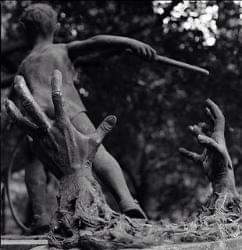REMEMBER JEWISH PIASKI, the first deportations from Piaski took place shortly after 16 March 1942, probably to make room for an influx of Jews from the Reich.
REMEMBER JEWISH PIASKI, the first deportations from Piaski took place shortly after 16 March 1942, probably to make room for an influx of Jews from the Reich. Approximately 3,400 Polish Jews and Jews from Stettin, who were deemed as ‘unfit for work,’ were marched to Trawniki, where they were held overnight in a barn at the former sugar refinery, together with some Jews from Biskupice. Several hundred of these people died from suffocation overnight.
The next day the corpses were loaded onto the cattle wagons along with the living deportees, to be sent to the Belzec death camp. Transports from the Reich to Piaski began on 23 March 1942, when approximately 1,000 Jews from Mainz and Darmstadt arrived in Piaski. According to Martha Bauchwitz, this transport arrived penniless.
Then on 28 March 1942, 985 Jews arrived from Berlin. On 1 April 1942, 1,000 Jews arrived in Piaski from the Theresienstadt fortress ghetto. Working-age Jews from this and the other transports in March 1942, such as Kurt Ticho Thomas, originally from Boskovice, Czechoslovakia were deployed as agricultural workers on nearby farms.
The deportations from Piaski to the death camps, via Trawniki, resumed on 6 April 1942, and on 11 April 1942, the German Security Police Transfer Office Piaski, itemised property seized from the Jews recently dispatched to Belzec. The propertylisted was 8,300.54 zloty, 85 gold rubles, and 5 wedding rings, as well as 45 men’s vests, 2 fur pelts, 9 pairs of children’s mittens and other goods.
According to official German records, there were further transports to Piaski on 6 April 1942, when 989 Jews arrived from Munich, and on 25 April 1942, when another 1,000 Jews arrived from Theresienstadt. However, more than 200 of the able-bodied men on each transport were selected in Lublin, probably for the Lublin concentration camp. On 19 May 1942, Zigenmeyer reported that 6,166 Jews from Piaski had been resettled.
The deportation necessitated the re-construction of the Judenrat in Piaski and the Jewish Police as well. Polisecki remained as Chairman, and the Judenrat had two more long- standing members, Moses Drajblat and Josef Aschmann.
The nine replacements had arrived on the recent transport from the Reich. They were Moritz Israel Fried, Ernst Schlosser, Siegfried Kugelmann, Fritz Sanger, Hugo Railing, Kurt Hirschmann, Ernst Böhm, Walter Guttsmann, and Friedrich-Wilhelm Kempner. The age range of the new Judenrat was from 28 to 62, and was decidedly middle-class in its composition.
The Jewish Police was also re-organized, with Stefan Reinemann oversaw 30 Reich and Protectorate Jews in the force, including one woman Bela Trattner. On 15 May 1942, the Reich Security Main Office (RSHA) banned Jews in the General Government from corresponding with relatives in the Reich or elsewhere, effectively cutting Piaski off from the world, apart from the JSS Lublin-Lands somewhat cursory replies to enquiries from relatives.
By June 1942, deportations of Western European Jews went direct to the Belzec and Sobibor death camps, which obviated the need for Piaski to serve as a transit ghetto.
The main deportation ‘Aktion’ took place during the period 22-30 October 1942, when some 5,000 Jews were deported to the Sobibor death camp, via Trawniki. On 23 October 1942, 3,000 Jews from the Leczna ghetto were marched to Piaski and from there, they shared the same fate, and were also deported to the Sobibor death camp, via Trawniki.
Also in October 1942, Higher-SS and Police Leader East Friedrich – Wilhelm Krüger, designated Piaski one of the few locations where Jews were allowed to reside in, the so-called ‘Jewish Residential districts,’ this was a ruse to tempt those Jews in hiding to return to the ghetto and thus be deported more easily.
In late October 1942, Krüger inspected Piaski to see if the ruse was working. Starting in November 1942, a small forced labour camp for Jews operated in Piaski, but this only lasted until March or April 1943, when the inmates were sent to the Trawniki labor camp.











Comments
Post a Comment